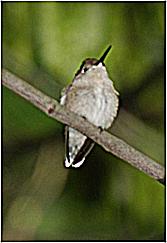| 09-08-03
There is more interesting lore on the ruby-throated hummingbird, especially
about its enemies.
Those who read this column and the corresponding web page (www.bayoubill.com)
may recall the column two weeks back in which we revealed some interesting
(and apparently little-known) habits of this diminutive avian.
In that column we drew from the writing of A.C. Bent, who penned a 21-volume
book on Life Histories of North American Birds. Bent's work is the
subject of a web page conducted by Ms. Pat Newforth, designer and manager
of my web page. Her web page can be found here Bent's
Familiar
Birds.
 In putting
that earlier column together for the edification of those who have been
unjustifiably bombarded with the notion that hummingbirds characteristically
do nothing but sip sugar water and fly, we also encountered some very interesting
information on enemies of the ruby-throat. In putting
that earlier column together for the edification of those who have been
unjustifiably bombarded with the notion that hummingbirds characteristically
do nothing but sip sugar water and fly, we also encountered some very interesting
information on enemies of the ruby-throat.
I had planned to follow the first column with Bent's interesting writing
on hummingbird enemies, but our unexpected late-August monsoon and the
opening of seasons on teal and doves (Sept. 1) took precedence.
But here are some of the interesting observations of Bent and his informants
and collaborators in his works, published from 1919 to 1968 by the Smithsonian
Institute, for which we have great respect:
"Enemies--In addition to the dangers of migration, notably
the occurrence of frost when the hummingbird overruns the advance of spring,
there are other hazards, chiefly of an accidental nature, imperiling the
life of the bird.
Ralph E. Danforth (1921) speaks of a bird caught in "a pendulous
mass of cobweb" from which he freed it with some difficulty, and Bradford
Torrey (1903) relates what he calls "a pretty story" told to him by an
observer whom he describes as "a seeing man." The man, hearing "the familiar,
squeaking notes of a hummer, and thinking that their persistency must be
occasioned by some unusual trouble, went out to investigate. Sure enough,
there hung the bird in a spider's web attached to a rosebush, while the
owner of the web, a big yellow-and-brown, pot-bellied, bloodthirsty rascal,
was turning its victim over and over, winding the web about it. Wings and
legs were already fast, so that all the bird could do was to cry for help.
And help had come. The man at once killed the spider, and then, little
by little, for it was an operation of no small delicacy, unwound the mesh
in which the bird was entangled."
Joseph Janiec sends the following story to Mr. Bent: "While I was
wandering through a large hollow one June afternoon, my attention was attracted
to the unusual waving of a pasture thistle. No air was stirring, and my
curiosity prompted me to ascertain the cause of the movements. As I approached
the thistle I noticed what I at first supposed to be a large dragonfly
impaled on the prickly purple flower; closer examination, however, revealed
a male ruby-throated hummingbird stuck to the flower, his wings not being
involved in the contact but his stomach feathers adhering to the prickly,
pointed stamens. Cutting off the flower, I carried it and the bird home
and carefully removed the bird. Although it lost a few feathers in the
operation, the little bird flew away unharmed."
There is a surprising record from California telling of the capture
of an unidentified species of hummingbird by a fish. Mary E. Lockwood (1922)
says, quoting from a letter: "We were seated by the lotus-pool when a hummingbird
flew and hovered over the pool. Suddenly a bass jumped from the water and
swallowed the hummingbird."
George H. Lowery, Jr. (1938) reports the following apparently unique
record:
I shot a female Eastern Pigeon Hawk (Falco columbarius columbarius)
on April 16, 1937, at Grand Isle, off the coast of Jefferson Parish, Louisiana.
Upon examination of its stomach contents, I was surprised to find the identifiable
remains of a Ruby-throated Hummingbird (Archilochus colubris). Later, on
a visit to Washington, D.C., I discussed the matter with Mr. Clarence Cottam,
Director of the Food Habits Division of the Bureau of Biological Survey.
With his permission and the assistance of Mr. Robert McClanahan of the
Food Habits offices, I went through the extensive records of that division
and found no species of hummingbird had ever heretofore been recorded from
any bird stomach
Norris-Elye writes to Mr. Bent: "During the summer of 1934, James
Ashdown, Jr., and his mother were walking in the woods at Kenora, Ontario,
and heard a continuous rattling. Investigation showed it to be a male ruby-throated
hummingbird on the ground, with a huge dragonfly on the bird's back; it
had seized the bird by the neck. They drove the dragonfly away, picked
up the bird, and held it in the palm of the hand for several minutes, after
which it flew away.
"We have had instances of frogs capturing and swallowing ruby-throats,
one at Gull Harbor and one at Gimli, Lake Winnipeg. The Gimli case was
observed by my friend Hugh Moncrieff, who captured the frog (leopard) and
had some boys cut it open to recover the bird, while he took some good
motion pictures of the operation."
|

